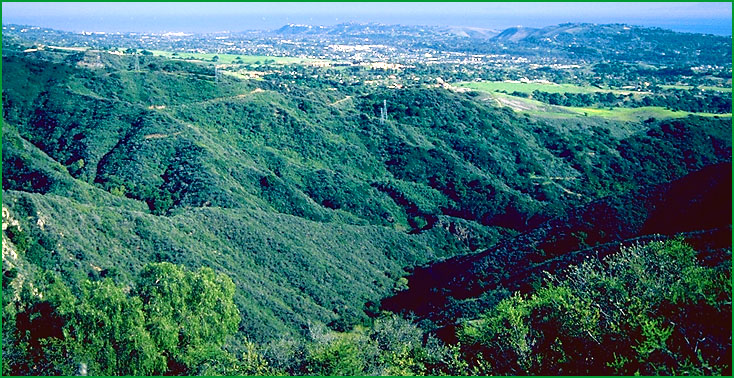 | Santa Ynez - Sulphur Mountains |
|
This subsection includes, from west to east, the Santa Ynez Mountains, the Ojai Valley, and the Sulphur Mountains. The climate is hot to temperate and subhumid. MLRAs 15d, 19d, and 20d.
Lithology and Stratigraphy. This subsection contains mostly Eocene, Oligocene, Miocene, and Pliocene marine sedimentary rocks, with some Cretaceous marine sedimentary rock. Quaternary alluvium is most extensive in the Ojai Valley and along the coast from Goleta to Carpinteria. There are some small areas of dissected Quaternary marine terraces and dune sand.
Geomorphology. The Santa Ynez Mountains is an east-west trending range of steep mountains with narrow ridges. The Sulphur Mountains trend more toward the west-southwest. They have broader ridges and there are remnants of Quaternary marine terraces on many of them. Floodplains, fluvial terraces, and alluvial fans are most extensive in Ojai Valley. There are small areas of dunes all along the coast. The subsection elevation range is from sea-level up to 4298 feet on Santa Ynez Peak and 4707 feet on Divide Peak. Mass wasting and fluvial erosion are the main geomorphic processes. Coastal marine and eolian processes are important along the coast.
Soils. The soils are mostly Lithic and Typic Xerorthents, Lithic Haploxerolls, and Typic Argixerolls on Cretaceous, Eocene, Oligocene and Miocene sedimentary rocks; and Calcixerollic Xerochrepts, Calcic Pachic Haploxerolls, and shallow Typic Xerorthents on Pliocene sedimentary rocks. Dystric Lithic Xerochrepts are common on Eocene sedimentary rocks in cooler areas. Also, there are Chromoxererts, Palexeralfs, and Haploxerolls on hills of mostly Miocene sedimentary rocks just above the alluvial plain from Goleta to Carpinteria. Haploxerolls, Haploxeralfs, Palexeralfs, and Argialbolls are common on Quaternary nonmarine terraces, and Fluventic and Cumulic Haploxerolls on floodplains. Most, but not all, of the soils are leached free of carbonates. The soils are mostly well drained. Soil temperature regimes are mostly thermic, but mesic on north-facing slopes at higher elevation. Soil moisture regimes are xeric.
Vegetation. The predominant natural plant communities are Coast live oak series in areas with thermic soil temperature regimes, Big-cone Douglas-fir - canyon live oak series in areas with mesic soil temperature regimes, Chamise series on shallow soils, and Mixed chaparral shrublands. There are smaller areas of Purple sage series, Bigpod ceanothus series, and Mixed scrub oak series. The dunes and adjacent uplands with a cover of eolian sand support a succession of plant communities, from bare dune through herbaceous communities and Coyote bush series to California sagebrush series on stabilized dunes.
Characteristic series by lifeform include:
Dunelands: Sand-verbena - beach bursage series, Dune lupine - goldenbush series.
Grasslands: California annual grassland series, Purple needlegrass series.
Shrublands: Bigberry manzanita series, Bigpod ceanothus series, Bigpod ceanothus - chamise series, Bigpod ceanothus - hollyleaf cherry series, Black sage series, California buckwheat series, California sagebrush series, California sagebrush - black sage series, California sagebrush series - California buckwheat series, California sagebrush - purple sage series, Chaparral yucca - California buckwheat series, Chamise series, Chamise - Bigberry manzanita series, Chamise - black sage series, Chamise - Eastwood manzanita series, Coyote brush series, Greenbark ceanothus series, Mixed sage series, Mixed scrub oak series, Purple sage series, Scrub oak series, Scrub oak - chamise series, White sage series.
Forests and woodlands: Bishop pine series, California bay series, California walnut series, Canyon live oak series, Coast live oak series, Tanoak series.
Climate. The mean annual precipitation is about 18 to 30 inches. It is practically all rain at lower elevations and mostly rain at higher elevations. Mean annual temperature is about 45░ to 60░ F. The mean freeze-free period is about 250 to 350 days.
Surface Water. Runoff is rapid. All but the larger streams are dry through the summer. Natural lakes are absent.
